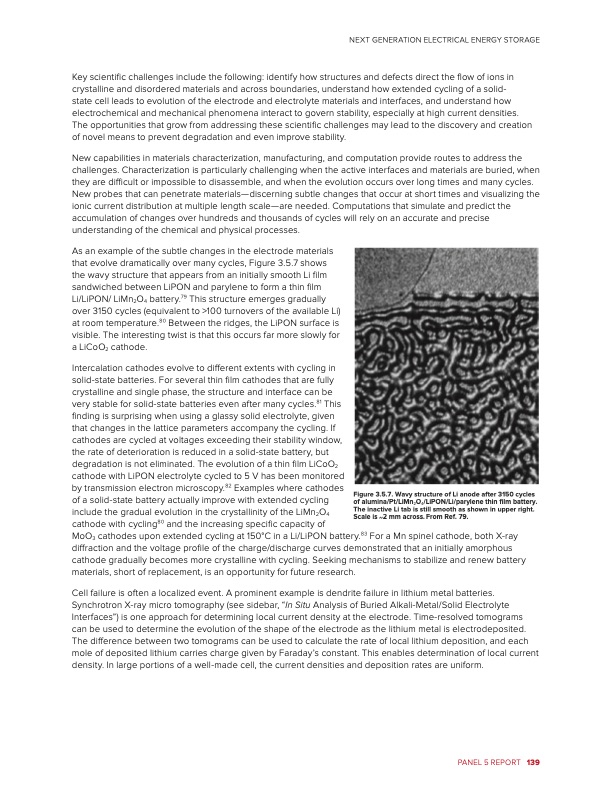
PDF Publication Title:
Text from PDF Page: 145
Key scientific challenges include the following: identify how structures and defects direct the flow of ions in crystalline and disordered materials and across boundaries, understand how extended cycling of a solid- state cell leads to evolution of the electrode and electrolyte materials and interfaces, and understand how electrochemical and mechanical phenomena interact to govern stability, especially at high current densities. The opportunities that grow from addressing these scientific challenges may lead to the discovery and creation of novel means to prevent degradation and even improve stability. New capabilities in materials characterization, manufacturing, and computation provide routes to address the challenges. Characterization is particularly challenging when the active interfaces and materials are buried, when they are difficult or impossible to disassemble, and when the evolution occurs over long times and many cycles. New probes that can penetrate materials—discerning subtle changes that occur at short times and visualizing the ionic current distribution at multiple length scale—are needed. Computations that simulate and predict the accumulation of changes over hundreds and thousands of cycles will rely on an accurate and precise understanding of the chemical and physical processes. As an example of the subtle changes in the electrode materials that evolve dramatically over many cycles, Figure 3.5.7 shows the wavy structure that appears from an initially smooth Li film sandwiched between LiPON and parylene to form a thin film Li/LiPON/ LiMn2O4 battery.79 This structure emerges gradually over 3150 cycles (equivalent to >100 turnovers of the available Li) at room temperature.80 Between the ridges, the LiPON surface is visible. The interesting twist is that this occurs far more slowly for a LiCoO2 cathode. Intercalation cathodes evolve to different extents with cycling in solid-state batteries. For several thin film cathodes that are fully crystalline and single phase, the structure and interface can be very stable for solid-state batteries even after many cycles.81 This finding is surprising when using a glassy solid electrolyte, given that changes in the lattice parameters accompany the cycling. If cathodes are cycled at voltages exceeding their stability window, the rate of deterioration is reduced in a solid-state battery, but degradation is not eliminated. The evolution of a thin film LiCoO2 cathode with LiPON electrolyte cycled to 5 V has been monitored by transmission electron microscopy.82 Examples where cathodes of a solid-state battery actually improve with extended cycling include the gradual evolution in the crystallinity of the LiMn2O4 cathode with cycling80 and the increasing specific capacity of MoO3 cathodes upon extended cycling at 150°C in a Li/LiPON battery.83 For a Mn spinel cathode, both X-ray diffraction and the voltage profile of the charge/discharge curves demonstrated that an initially amorphous cathode gradually becomes more crystalline with cycling. Seeking mechanisms to stabilize and renew battery materials, short of replacement, is an opportunity for future research. Cell failure is often a localized event. A prominent example is dendrite failure in lithium metal batteries. Synchrotron X-ray micro tomography (see sidebar, “In Situ Analysis of Buried Alkali-Metal/Solid Electrolyte Interfaces”) is one approach for determining local current density at the electrode. Time-resolved tomograms can be used to determine the evolution of the shape of the electrode as the lithium metal is electrodeposited. The difference between two tomograms can be used to calculate the rate of local lithium deposition, and each mole of deposited lithium carries charge given by Faraday’s constant. This enables determination of local current density. In large portions of a well-made cell, the current densities and deposition rates are uniform. NEXT GENERATION ELECTRICAL ENERGY STORAGE Figure 3.5.7. Wavy structure of Li anode after 3150 cycles of alumina/Pt/LiMn2O4/LiPON/Li/parylene thin film battery. The inactive Li tab is still smooth as shown in upper right. Scale is ~2 mm across. From Ref. 79. PANEL 5 REPORT 139PDF Image | Next Generation Electrical Energy Storage

PDF Search Title:
Next Generation Electrical Energy StorageOriginal File Name Searched:
BRN-NGEES_rpt-low-res.pdfDIY PDF Search: Google It | Yahoo | Bing
Sulfur Deposition on Carbon Nanofibers using Supercritical CO2 Sulfur Deposition on Carbon Nanofibers using Supercritical CO2. Gamma sulfur also known as mother of pearl sulfur and nacreous sulfur... More Info
CO2 Organic Rankine Cycle Experimenter Platform The supercritical CO2 phase change system is both a heat pump and organic rankine cycle which can be used for those purposes and as a supercritical extractor for advanced subcritical and supercritical extraction technology. Uses include producing nanoparticles, precious metal CO2 extraction, lithium battery recycling, and other applications... More Info
| CONTACT TEL: 608-238-6001 Email: greg@infinityturbine.com | RSS | AMP |